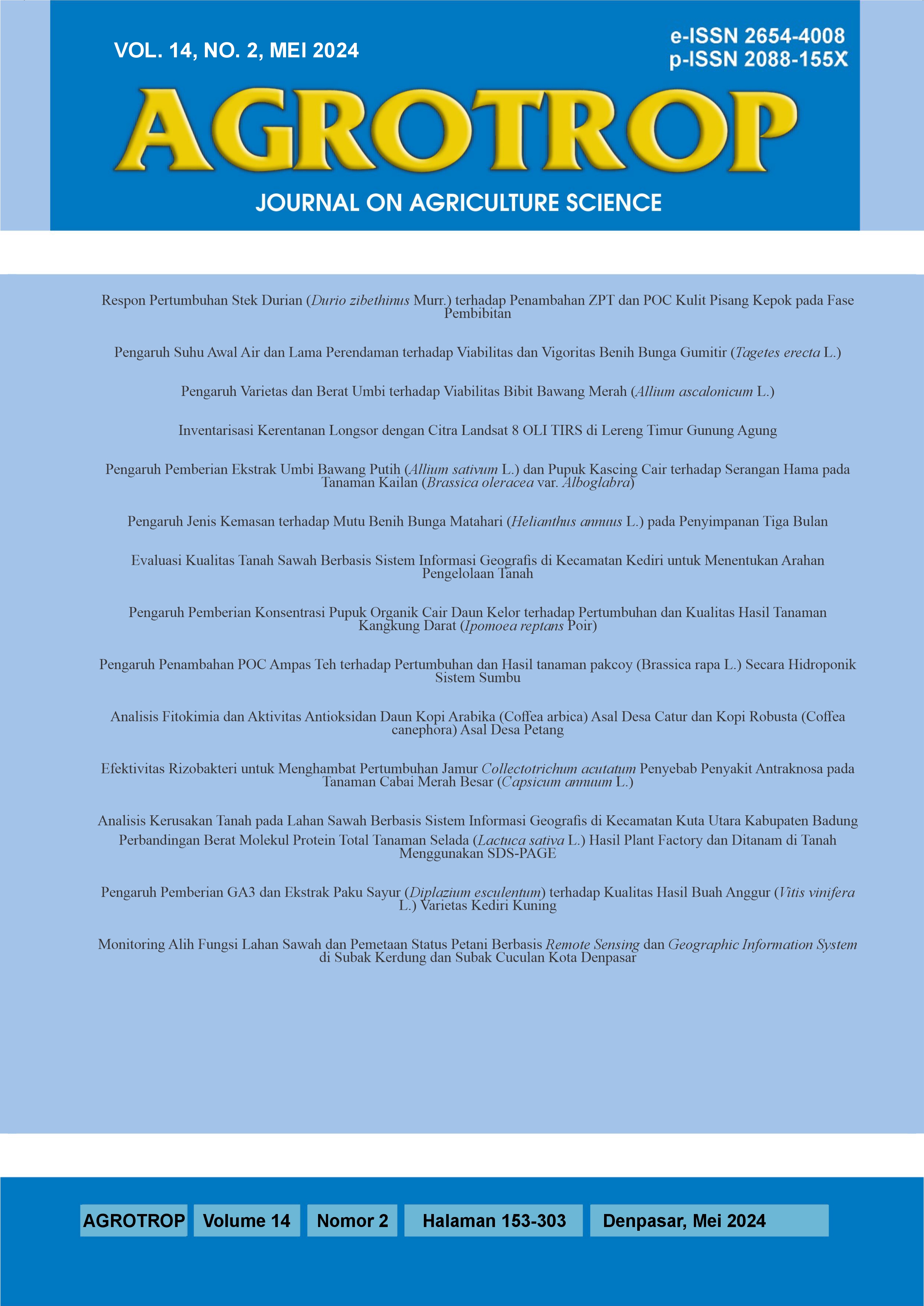Analisis Fitokimia dan Aktivitas Antioksidan Daun Kopi Arabika (Coffea arbica) Asal Desa Catur dan Kopi Robusta (Coffea canephora) Asal Desa Petang
Abstract
Phytochemical Content Identification and Antioxidant Activity Test of Arabica Coffee Leaves (Coffea arabica) in the Catur Village and Robusta Coffee Leaves (Coffea canephora) in the Petang Village. Coffee is considered one of valuable crops commodity, and its cultivation generates waste in the form of coffee leaves. Indeed, it is necessary to make use of this waste for the better Environment, in this case, researchers took the sample of arabica leaves in Catur village and the sample of robusta leaves in Petang village. Researchers conducted a study to identify compounds and determine the antioxidant activity of arabica coffee leaves (Coffea arabica) and robusta coffee leaves (Coffea canephora). The researchers employed GC-MS and for phytochemical analysis and the DPPH method to evaluate antioxidant activity. The results revealed that the viscous extract of both arabica and robusta coffee leaves contained Caffeine as the most prominent compound. Caffeine is known for its stimulating effect on the central nervous system and anti-inflammatory. In the viscous extract of arabica coffee leaves contained 48 substances and the viscous extract of robusta coffee leaves contained 9 substances were identified with a qual >90. The IC50 value for the viscous extract of arabica coffee leaves was measured at 91,837 ppm, indicating a strong-class antioxidant activity. In contrast, the IC50 value for the viscous extract of robusta coffee leaves was 120,972 ppm, representing a medium-class antioxidant activity.
Downloads
References
Dellayanti, G. A. (2022). Analisis Nilai Tambah Kopi Robusta Di Desa Sepang Kelod Busungbiu Buleleng. Undergraduate thesis.. s.l.:Universitas Pendidikan Ganesha.
EPA, A. T. (2000). United States Environmental Protection Agency.Available Online at: https://comptox.epa.gov/dashboard/ [Accessed 31 mei 2023].
Hasanah, M., Maharani, B. & Munarsih, E. (2017). Daya Antioksidan Ekstrak Dan Fraksi Daun Kopi Robusta (Coffea robusta) Terhadap Pereaksi DPPH (2,2-difenil-1-pikrilhidrazil). Journal of Pharmaceutical Science and Technology, Volume 4(2): 42-49.
Prastowo, B., Kamawati, E., Rubiyo., Siswanto., Indrawanto, C. & Munarso, S. J. (2010). Budidaya Pascapanen Kopi. Jakarta: Eska Media bekerjasama dengan Pusat Penelitian dan Perkembangan Perkebunan.
PubChem. (2005). National Library of Medicine. Available Online at: https://pubchem.ncbi.nlm.nih.gov/ [Accessed 5 mei 2023].
Wirawan, I. G. P., Dewi, N. K. E. S., Sasadara, M. M. V., Sunyamurti, I. G. N. A., Jawi. I. M., Wijaya, I. N. & Krisnandika, A. A. K. (2022). Phytochemical Analysis and Molecular Identification of Green Macroalgae caulerpa spp. from Bali, Indonesia. Molecules, Volume 27(15): 4879.
Zuhra, C., Tarigan, J. B. & Sihotang, H. (2008). Aktivitas Antioksidan Senyawa Flavonoid dari Daun Katuk (Saoropus androgonus(L) Merr.). Jurnal Biologi Sumatra, Volume 3(1): 7-10.











